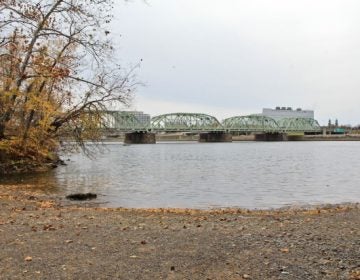The U.S. Army Corps wants to elevate 6,000 N.J. homes to protect them from storms
The plan is not yet funded and is still subject to change. Construction could begin as early as 2030.

A flood warning sign installed in Sea Isle City. (Image courtesy of Sea Isle City government)
This story is part of the WHYY News Climate Desk, bringing you news and solutions for our changing region.
From the Poconos to the Jersey Shore to the mouth of the Delaware Bay, what do you want to know about climate change? What would you like us to cover? Get in touch.
More than 6,000 homes along the Jersey Shore could be elevated in the coming decades to protect them from flooding under a U.S. Army Corps of Engineers plan.
The plan released Friday is a new, scaled-back version of a 2021 plan to prepare the state’s back bays for stronger storms and rising seas resulting from climate change. The Army Corps called the new plan “more achievable in the near-term.”
The Army Corps, in partnership with the New Jersey Department of Environmental Protection, started studying solutions for the worsening flood risk along the bays behind New Jersey’s barrier islands after Hurricane Sandy revealed the area’s vulnerability to storms. Sandy damaged over 100,000 structures in Atlantic, Burlington, Cape May, Monmouth and Ocean counties, causing more than $4 million worth of damage.
While the ocean-side coastline is already protected by bulkheads, seawalls and periodic beach nourishment, less attention has been paid to fortifying the bay-side coasts, the Army Corps said. Without further action to protect the back bays, the 3,500 miles of shoreline from Long Branch to Cape May Point would likely suffer on average $2.6 billion in damage to property, infrastructure and vehicles each year from 2040 to 2090, the Army Corps estimated.

In public meetings and reports over the last few years, the Army Corps has floated possible solutions ranging from living shorelines to floodwalls.
An earlier “tentatively selected plan” released in 2021 recommended storm surge barriers with moveable gates at three coastal inlets and levee-like cross bay barriers — estimated to cost over $16 billion. It also recommended flood walls, levees, and seawalls to tie these barriers to higher ground, and the elevation of more than 18,000 homes and businesses. But the structural plans in this report were later “determined to be inactionable and not implementable,” according to the Army Corps.
The updated plan released Friday is a significantly scaled down version with a much lower price tag. It recommends elevation of just over 6,000 homes, floodproofing close to 300 critical infrastructure facilities, such as hospitals and fire stations, and salt marsh restoration.
The Army Corps has identified 6,421 flood-prone homes that may be eligible for elevation, with many in areas such as Little Egg Harbor, Atlantic City, Long Beach Island and Point Pleasant. Participation in the elevation program would be voluntary, and homeowners would need to apply, according to the plan.
Notably, the new plan does not include storm surge barriers and other structural solutions, although it recommends further study on their feasibility.
The Army Corps’ analysis found that while storm surge barriers and cross bay barriers would be effective at controlling flooding, there was uncertainty surrounding their ability to be implemented, as well as around how they could impact water quality and circulation. Elevating individual buildings and restoring wetlands were considered less effective at controlling flooding, but more cost-efficient. The Army Corps’ analysis painted solutions such as floodwalls and levees as potentially dangerous in the event of a failure.
The N.J. Department of Environmental Protection sees the Army Corps’ focus on building elevation and nature-based solutions as a “sensible and cost-effective approach for enhancing resilience,” within the back bay areas, said DEP spokesperson Vincent Grassi in a written statement.
The Army Corps estimates that implementing the home elevations, floodproofing and nature-based solutions would cost $7.6 billion, with the federal government paying 65%. Construction would likely take place between 2030 and 2041 — although implementation is “highly dependent on Congressional approval and funding,” the plan states.
The plan is still subject to change, and it has not yet been funded.
The Army Corps and DEP will hold a virtual public meeting Jan. 22 to provide more information about the plan, and members of the public can comment on it through Feb. 18, 2025.

Get daily updates from WHYY News!
WHYY is your source for fact-based, in-depth journalism and information. As a nonprofit organization, we rely on financial support from readers like you. Please give today.






